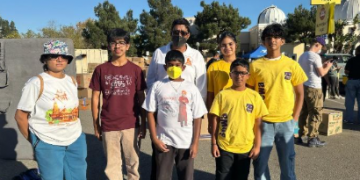Celebrating and Worshipping the Feminine Deities of Hinduism
By Swati Kapse, 2021 March 21
Ya devi sarva bhutesu, shanti rupena sansitha
Ya devi sarva bhutesu, shakti rupena sansthita
Ya devi sarva bhutesu, matra rupena sansthita
Namastasyai, namastasyai, namastasyai, namo namaha!
Devi Stotra
The Devi Stotra depicts the extensive attributes of the feminine Goddess in Sanatan Dharma. The Goddess who is omnipresent is the personification of the Universal Mother, she symbolizes peace yet she is the embodiment of enormous power that can destroy evil. So we bow to that powerful motherly feminine form called Devi.
Hindus worship the feminine form as ‘Shakti’ which represents the vigorous power and energy flowing in this Universe. This Shakti is manifested for the very purpose of destroying evil and protecting the good, so she is powerful and fierce.
Durga, Kaali, Parvati, Lakshmi, Saraswati are some of the forms of Shakti that Hindus worship. Although the worship of Goddess is year-round, there are two special times in a year- called ‘Navratri’ when feminine form Shakti is celebrated and worshipped for nine days and nights. Nava means nine and Ratri means night.
The two Navaratri times in the year are as follows
-
Vasant or Chaitra Navratri : This is celebrated around March-April and is a start of Hindu New Year time and also the start of the spring season.
-
Sharad Navratri is celebrated around October-November time and is the start of the winter season.
Navratri significance and celebration
The Navratri celebration marks the change of seasons. The Chaitra Navratri marks the arrival of spring and Sharad Navratri marks the arrival of winter.
During Navratri time, a lot of people fast for nine days. The significance of fasting during this time has spiritual as well as scientific reasons. Fasting is deep-rooted in Hindu culture and it has a relation to Human Anatomy. Human cells have mitochondria, which are called the powerhouse of the body. It works constantly to provide energy to the cell. Fasting gives it time to rejuvenate and regain its energy. People fast during this time to prepare their bodies for the next season. It energizes them for spring and keeps them healthy during winter.
The significance for specifically celebrating the feminine power (Goddess) during this time can also be thought of in the following way. The mitochondrial DNA exclusively comes from mothers to children and hence the worship and respect of the mother or the Shakti who imparts that life force to all of us.
People also come together during the evening time and do a specific form of dance called ‘Garba’. Garba has become a very popular part of Navratri. Dancing is the best way to bring out the potential energy, express devotion and happiness. It is a known fact that music and dance relaxes one’s mind and brings out positive energy in all.
Navratri nine days are divided into sets of three days each where people worship three different forms of Shakti
Days 1- 3
Worship of the Goddess in the form of Durga or Kali. She is the warrior draped in red and riding a lion.
Days 4 – 6
Worship of the Goddess in the form of Lakshmi. She is the Goddess of wealth and prosperity. She is dressed in gold and standing on a lotus.
Days 7 – 9
Worship of the Goddess in the form of Saraswati. She represents Knowledge. She is dressed in white and sitting on a white swan.
From the spiritual perspective, the progression of worship on these nine days represent one’s journey from the worldly activity where you have to do your karma with vigor to protect the dharma, live to earn materialistic gains to sustain life and slowly turn your attention to gain that ultimate knowledge of the Supreme.
Navaratri aptly depicts the celebration of the victory of good over evil as Goddess Durga killed demon Mahishasura to bring peace to the world.
In conclusion, we all should not only celebrate Navaratri with the same positive energy but also be aware of the spiritual, cultural, and scientific significance.



















